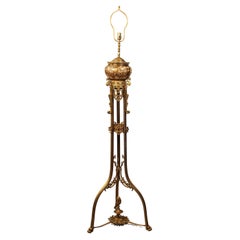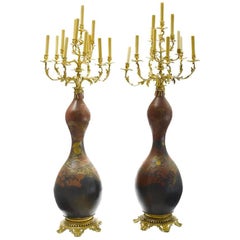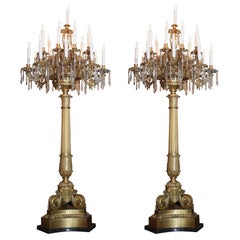Satsuma Floor Lamps
to
1
1
Height
to
Width
to
1
1
1
1
1
1
1
1
1
1
1
1
1
18
237
182
172
138
Creator: Satsuma
Late 19th Century Gilt Bronze and Japanese Satsuma Porcelain Floor Lamp
By Satsuma
Located in Long Island City, NY
Late 19th Century Gilt Bronze and Japanese Satsuma Porcelain Floor Lamp
The round lamp with painted scenes of men, women and children in landscape scenes and at leisure...
Category
Late 19th Century Japanese Belle Époque Antique Satsuma Floor Lamps
Materials
Bronze, Ormolu
Related Items
Pair 19th Century Japanese Porcelain and Gilt Bronze Mounted Torchere Floor Lamp
By Imari Porcelain
Located in Los Angeles, CA
A fine pair of 19th century Japanese porcelain and French gilt bronze mounted thirteen-light celadon torchiere, floor lamp candelabra. Wired for ...
Category
19th Century Japanese Rococo Antique Satsuma Floor Lamps
Materials
Bronze
$29,850 / set
H 64.25 in Dm 25 in
Large 19th c. French Bronze Doré and Crystal 19-Light Torchieres/candelabrum
Located in Houston, TX
These Palace size French 19-light torchieres are electrified and have new wiring; this exceptional pair is a rare find with the
original gilding in beautiful condition. They are pho...
Category
Mid-19th Century French Antique Satsuma Floor Lamps
Materials
Bronze
$60,000 Sale Price / set
20% Off
H 78 in W 32 in D 32 in
Bronze Mid Century Floor Lamp
By Hansen
Located in San Francisco, CA
Sculptural Patinated Bronze Square Floor Lamp sitting on a rosewood plinth base by Lawerence & Scott. This iconic design was featured in several of Ma...
Category
Mid-20th Century American Mid-Century Modern Satsuma Floor Lamps
Materials
Bronze
Floor Lamp Wood Barley Twist Column, RE 19th Century, Arts and Crafts Spain
Located in Mombuey, Zamora
19th Century or early 20th century
Floor lamp in the shape of a wooden solomon column.
* The measurement is of the wood, the lampshade is not included in the measurements or in the...
Category
19th Century Spanish Victorian Antique Satsuma Floor Lamps
Materials
Wood
$2,281 Sale Price
20% Off
H 59.06 in W 15.75 in D 15.75 in
Pair 19th Century Japanese Satsuma Vases / Lamps
By Satsuma
Located in Brighton, Sussex
A very good quality pair of Japanese Meiji period (1868-1912) Satsuma porcelain vases / lamps.
Each with wonderful gilded classical motif decoration, with inset hand painted panels depicting various scenes of courtiers in attendance and Samurai warriors. Both mounted on ormolu oriental stands.
Category
Late 19th Century Japanese Japonisme Antique Satsuma Floor Lamps
Materials
Porcelain
Pair 19th Century Japanese Imari Porcelain & Gilt-Bronze Torchere Candelabra
By Imari Porcelain
Located in Los Angeles, CA
A fine Pair of 19th century Japanese Imari Porcelain and French Gilt-Bronze Mounted Thirteen-Light Celadon Torchere Candelabra. The bottle-shaped Japonisme vases with a Royal red background, decorated with parcel-gilt and black soaring eagles in the hunt within a forestall scene. Each Vase fitted and surmounted with a French 19th century Louis XV Style 13-Light scrolled candelabrum and all raised on a circular pierced gilt-bronze plinth. circa: 1880.
Imari Porcelain (????) is the name for Japanese porcelain wares made in the town of Arita, in the former Hizen Province, northwestern Kyushu. They were exported to Europe extensively from the port of Imari, Saga, between the second half of the 17th century and the first half of the 18th century. The Japanese as well as Europeans called them Imari. In Japanese, these porcelains are also known as Arita-yaki (???). Imari or Arita porcelain has been continously produced up through the present day.
Characteristics
Though there are many types of Imari, Westerners' conception of Imari in the popular sense is associated only with a type of Imari produced and exported in large quantity in mid-17th century. This type is called Kinrande. Kinrande Imari is colored porcelain with cobalt blue underglaze and red and gold overglaze. The color combination was not seen in China at that time. Traditional Ming dynasty color porcelain used dominantly red and green, probably due to scarcity of gold in China, whereas gold was abundant in Japan in those days. The subject matter of Imari is diverse, ranging from foliage and flowers to people, scenery and abstractions. Some Imari design structures such as kraak style were adopted from China, but most designs were uniquely Japanese owing to the rich Japanese tradition of paintings and costume design. The porcelain has a gritty texture on the bases, where it is not covered by glaze. There is also blue and white Imari. Kakiemon style Imari is another type of Imari, but it tends to be categorized separately in Europe.
History
"Imari" was simply the trans-shipment port for Arita wares. It was the kilns at Arita which formed the heart of the Japanese porcelain industry.
Arita's kilns were set up in the 17th century, when kaolin was discovered in 1616 by the immigrant Korean potter, Yi Sam-pyeong (1579–1655). (He may also be known by the name, "Kanage Sambei".) Yi Sam-Pyeong, along with his extended family of 180 persons, left Korea on the offer of a privileged position in Japan. This decision was made after the occurrence of certain Japanese invasions of Korea. After Yi Sam-Pyeong's discovery, his kilns began to produce revised Korean-style blue and white porcelains, known as "Shoki-Imari".
In the mid-17th century there were also a lot of Chinese refugees in Northern Kyushu due to the turmoil on Chinese continent, and it is said one of them brought coloring technique to Arita. Thus Shoki-Imari developed into Ko-KutaniImari. Ko-Kutani was produced around 1650 for both export and domestic market. Blue and white porcelain continued to be produced and they are called Ai-Kutani. Ko-Kutani Imari for the export market usually adopted Chinese design structure such as kraak style, whereas Ai-Kutani for the domestic market were highly unique in design and are accordingly valued very much among collectors.
Ko-Kutani style evolved into Kakiemon style Imari, which was produced for about 50 years around 1700. Imari achieved its technical and aesthetic peak in Kakiemon style, and it dominated European market. Blue and white Kakiemon is called Ai-Kakiemon. Kakiemon style transformed into Kinrande in the 18th century. Kinrande used blue underglaze and red and gold overglaze, and later some other colors.
Imari began to be exported to Europe because the Chinese kilns at Ching-te-Chen were damaged in the political chaos and the new Qing dynasty government stopped trade in 1656–1684. Exports to Europe were made through the Dutch East India Company, but the designation "Imari Porcelain" in Europe connotes Arita wares of mostly Kinrande Imari.
Export of Imari to Europe stopped in mid-18th century when China began export to Europe again, since Imari was not able to compete against China due to high labor cost. By that time, however, both Imari and Kakiemon style were already so popular among Europeans, Chinese export porcelain copied both Imari and Kakiemon style, which is called Chinese Imari. At the same time, European kilns, such as Meisen also tried to copy Imari and Kakiemon.
Export of Imari surged again in late 19th century (Meiji era) when Japonism flourished in Europe. Thus in western world today, two kinds of Imari can...
Category
19th Century Japanese Japonisme Antique Satsuma Floor Lamps
Materials
Bronze, Ormolu
$24,850 Sale Price / set
49% Off
H 72.25 in Dm 24.25 in
Very Important Satsuma Porcelain Lamp
By Satsuma
Located in Saint-Ouen, FR
Very Important Satsuma Porcelain lamp, mounted in Gilt Bronze and silk shade (very damaged, but historical), 19th century, Napoleon III period, Great de...
Category
19th Century Japanese Antique Satsuma Floor Lamps
Materials
Porcelain
19th Century French Marble and Gilt Bronze Fine Floor Lamp
Located in Dallas, TX
19th century French gilt bronze and marble floor lamp . Fine quality gilt bronze detail.
Category
Mid-19th Century French Empire Antique Satsuma Floor Lamps
Materials
Marble
19th Century Antique Japanese Meiji Bronze Floor Lamp
Located in Point Richmond, CA
19th century antique Japanese Meiji bronze floor lamp.
This finely cast, well composed, pedestal lamp depicts mythical creatures on the base, cranes in high relief on the stem are...
Category
Late 19th Century Japanese Meiji Antique Satsuma Floor Lamps
Materials
Bronze
Italian Murano Glass and Bronze Floor Lamp
By Pietro Chiesa, Fontana Arte, Jacques Adnet, Max Ingrand
Located in Houston, TX
Italian Murano glass and bronze floor lamp.
Chic Italian Modern Fontana Arte style modernist floor lamp of bronze with glass tubes, newly w...
Category
1940s Italian Mid-Century Modern Vintage Satsuma Floor Lamps
Materials
Bronze
Italian Brass and Porcelain Floor Lamp
Located in Antwerp, BE
Beautiful Italian brass and porcelain floor lamp. The lamp has a lovely porcelain with beautiful flowers. The shades are not included in the price....
Category
Mid-20th Century Italian Hollywood Regency Satsuma Floor Lamps
Materials
Brass
Pair of Gilt Bronze Standing Floor Lamps
Located in London, GB
Each floor lamp in this pair is constructed from gilt bronze and designed in a neoclassical manner to imitate the appearance of a Corinthian column. Each lamp is formed from a fluted...
Category
Early 20th Century French Neoclassical Satsuma Floor Lamps
Materials
Ormolu, Bronze
Satsuma floor lamps for sale on 1stDibs.
Satsuma floor lamps are available for sale on 1stDibs. These distinctive items are frequently made of porcelain and are designed with extraordinary care. Prices for Satsuma floor lamps can differ depending upon size, time period and other attributes — on 1stDibs, these items begin at $2,750 and can go as high as $2,750, while a piece like these, on average, fetch $2,750.
Questions About Satsuma Floor Lamps
- 1stDibs ExpertApril 5, 2022Satsuma porcelain or pottery includes a maker’s mark with the name of the person who made the item. Japanese numbers may also indicate that a Satsuma piece was part of a collection. Genuine Satsuma pieces will not have a “Made in Japan” label and should only include Japanese characters. When in doubt, work with a certified appraiser to determine the authenticity of your Satsuma piece. Find a variety of expertly vetted Satsuma porcelain and pottery collectibles on 1stDibs.
- Is Satsuma pottery valuable?1 Answer1stDibs ExpertApril 26, 2024Yes, some Satsuma pottery is valuable. The age, type, style and condition will determine how much a particular piece is worth. In addition, the history of ownership may also make a piece more valuable. For example, if a piece was previously in the collection of a notable person, such as a member of the Japanese Imperial Family, it may be worth more. To get an estimated value for a particular piece, consult a certified appraiser or knowledgeable antiques dealer. Find a range of Satsuma pottery on 1stDibs.
- 1stDibs ExpertOctober 7, 2024The difference between Satsuma and moriage is that the former is a type of pottery, and the latter is a technique for decorating pottery. Satsuma pottery is the term for earthenware pottery from Japan's Satsuma region. Although there are different styles, the most common element of Satsuma pottery is a heavy, dark glaze. Moriage is the term for when potters add raised slip decorations to pottery, creating a three-dimensional effect. Some Satsuma pieces show off moriage details, while others do not. Shop a range of Satsuma pottery on 1stDibs.
- How do I date a Satsuma vase?1 Answer1stDibs ExpertMarch 22, 2022To date a Satsuma vase, study its mark. Vases made before World War II normally feature a mark in Japanese. A vase that says "Royal Satsuma" likely dates back to the late 20th century. You'll find a variety of expertly vetted Satsuma vases on 1stDibs.
- What is a Japanese Satsuma vase?1 Answer1stDibs ExpertOctober 12, 2021A type of Japanese pottery originated from Satsuma province in Japan is termed as Satsuma ware. A vase of this kind is known as a Satsuma vase. An interesting fact about Satsuma ware is that they feature a "makers mark" or marking as a key to help collectors unlock the value, age and authenticity of the piece. Shop a range of antique and vintage Japanese vases on 1stDibs.
- 1stDibs ExpertNovember 4, 2024To identify Satsuma pottery marks, you'll typically need to perform research using trusted online resources. Satsuma is a region in Japan known for its pottery, and many factories and artisans have operated there, including Kinkozan, Taizan, Yasuda, Choshuzan, Fuzan, Gyozan, Koshida and Maruni Kobe. Each maker has its own marks associated with it, and these typically are in Japanese kanji characters. You can compare the characters on your piece to pictures shared online to find a match. Alternatively, a certified appraiser or experienced antique dealer can help you identify your pottery markings. On 1stDibs, shop a selection of Satsuma pottery.
- 1stDibs ExpertFebruary 1, 2024One way to tell if your Satsuma vase is valuable is to look for markings on it. The oldest and typically most expensive pieces will usually have the Shimazu family crest — a circle with a cross through it — hand-painted on the bottom. If the piece is stamped with the marking or says "Made in Japan" in the Roman alphabet, it is a newer vase. Factors like the style of the vase and its condition will also impact its price. It's a good idea to have a certified appraiser or knowledgeable dealer evaluate your vase to determine its value. Find a variety of Satsuma vases on 1stDibs.
- 1stDibs ExpertSeptember 9, 2024Yes, some Satsuma pottery is worth something. Depending on their age, maker, type, style, condition and other factors, pieces may sell for a few hundred to several thousand dollars. Looking at sales and auction histories can give you a rough idea of the value of a piece. For a more definitive valuation, use the services of a certified appraiser or knowledgeable antique dealer. On 1stDibs, explore a collection of Satsuma pottery.


